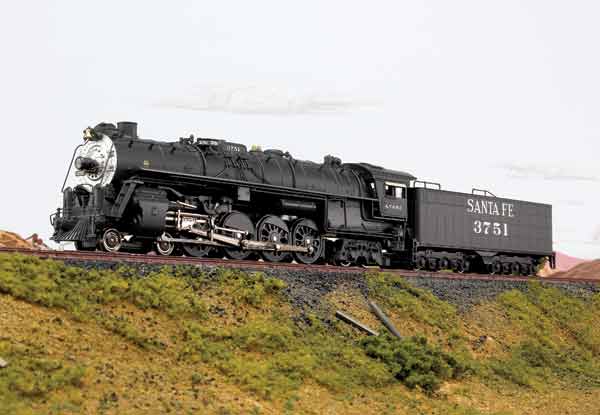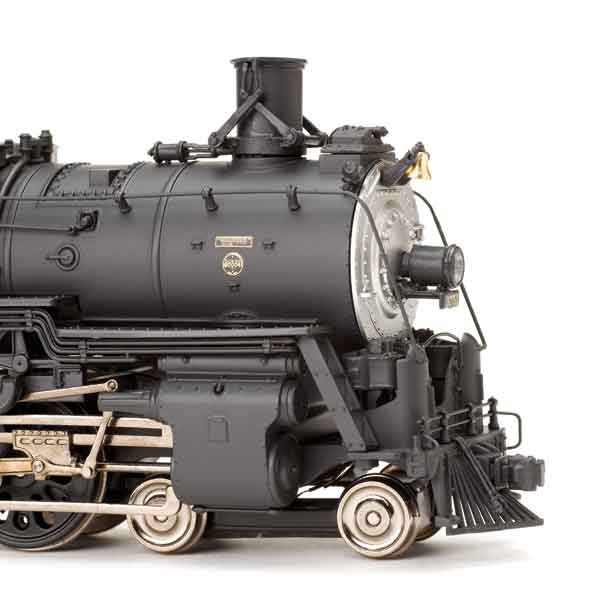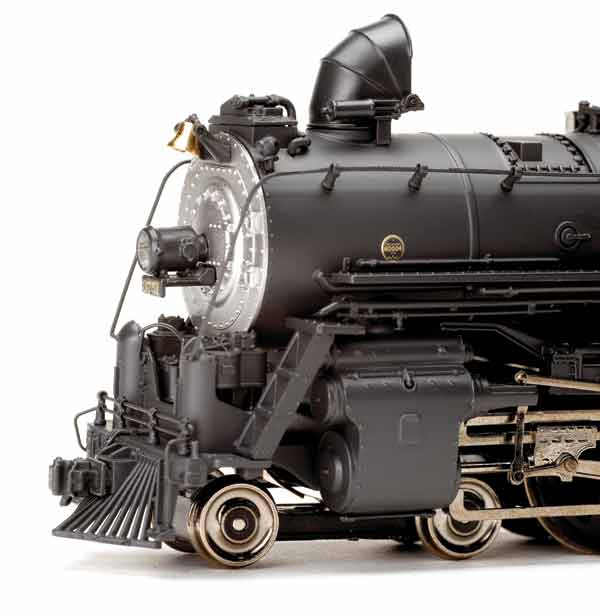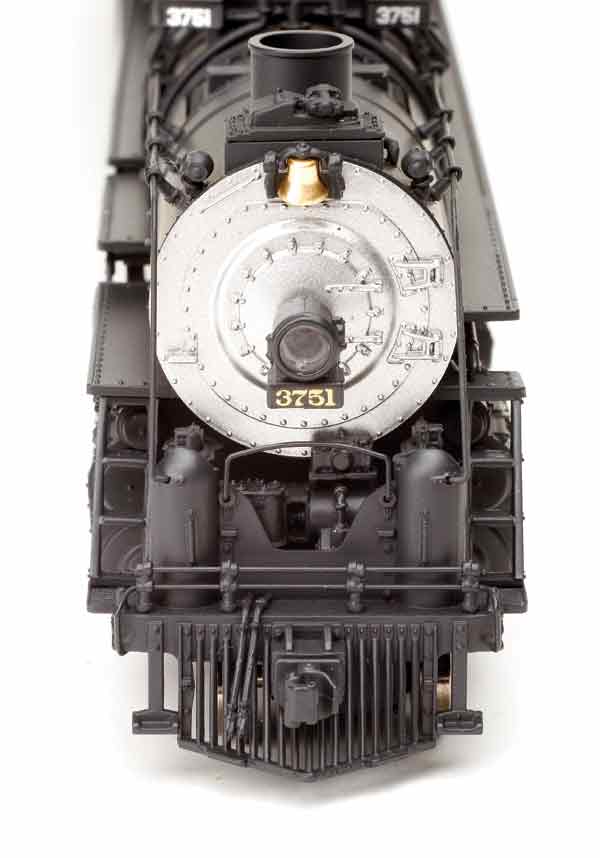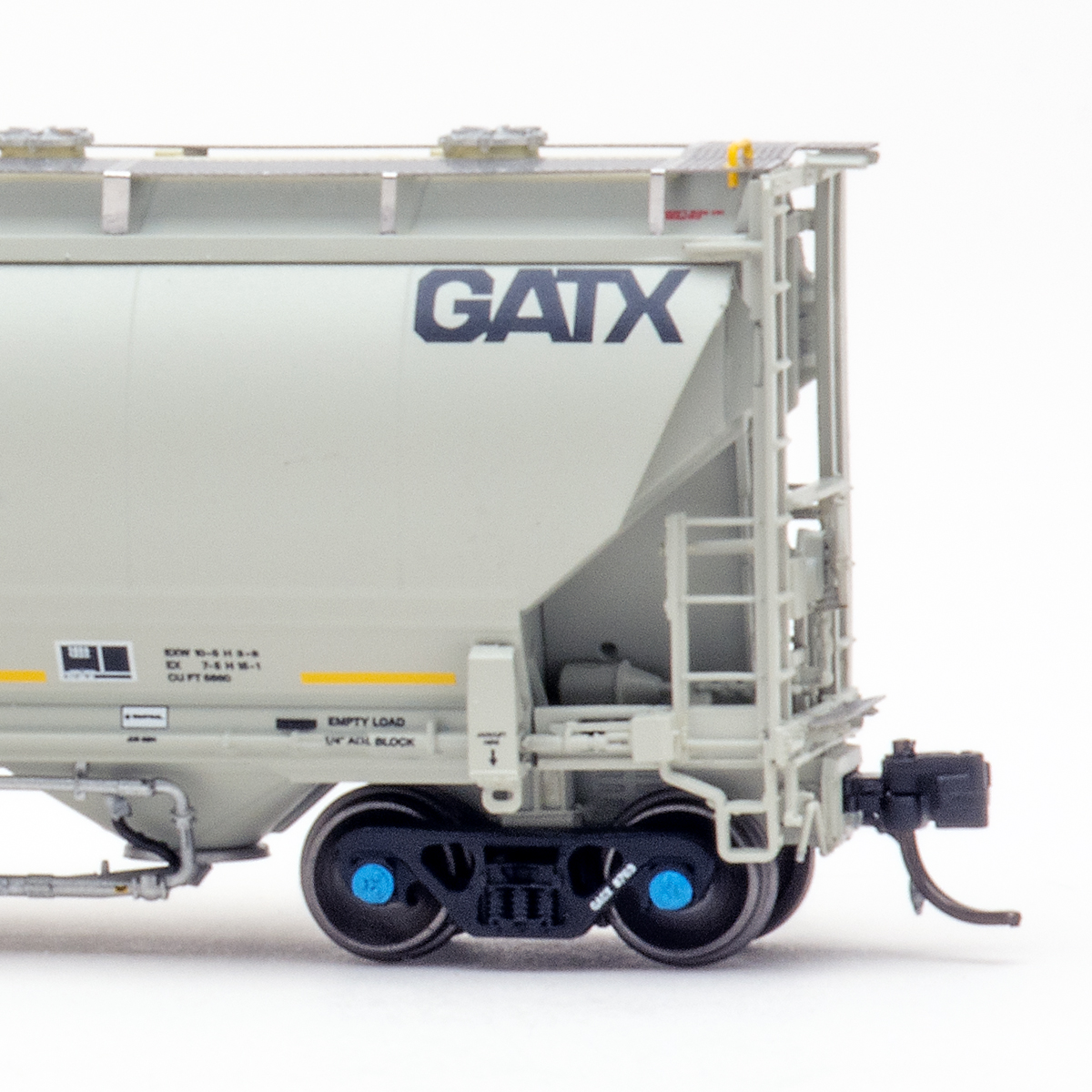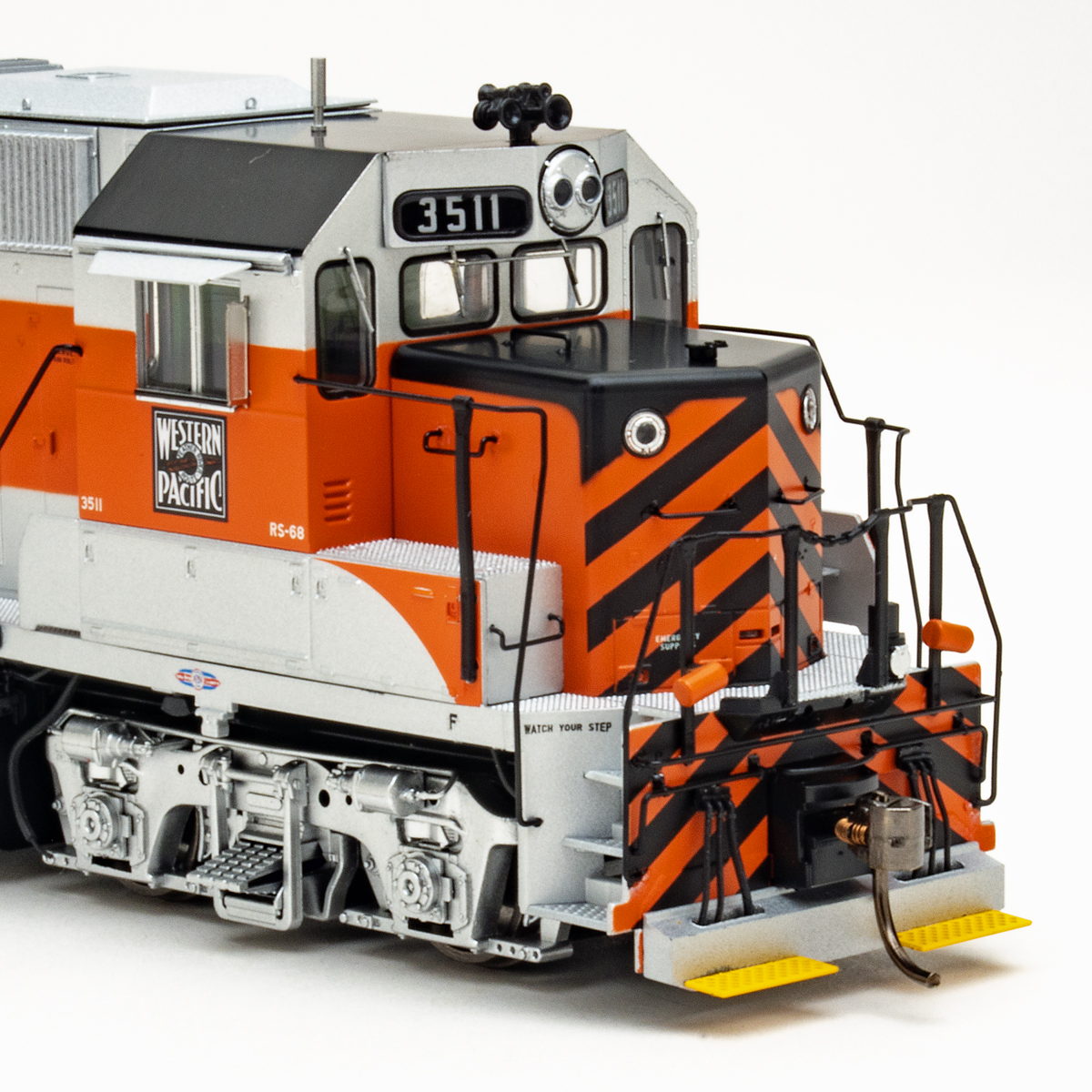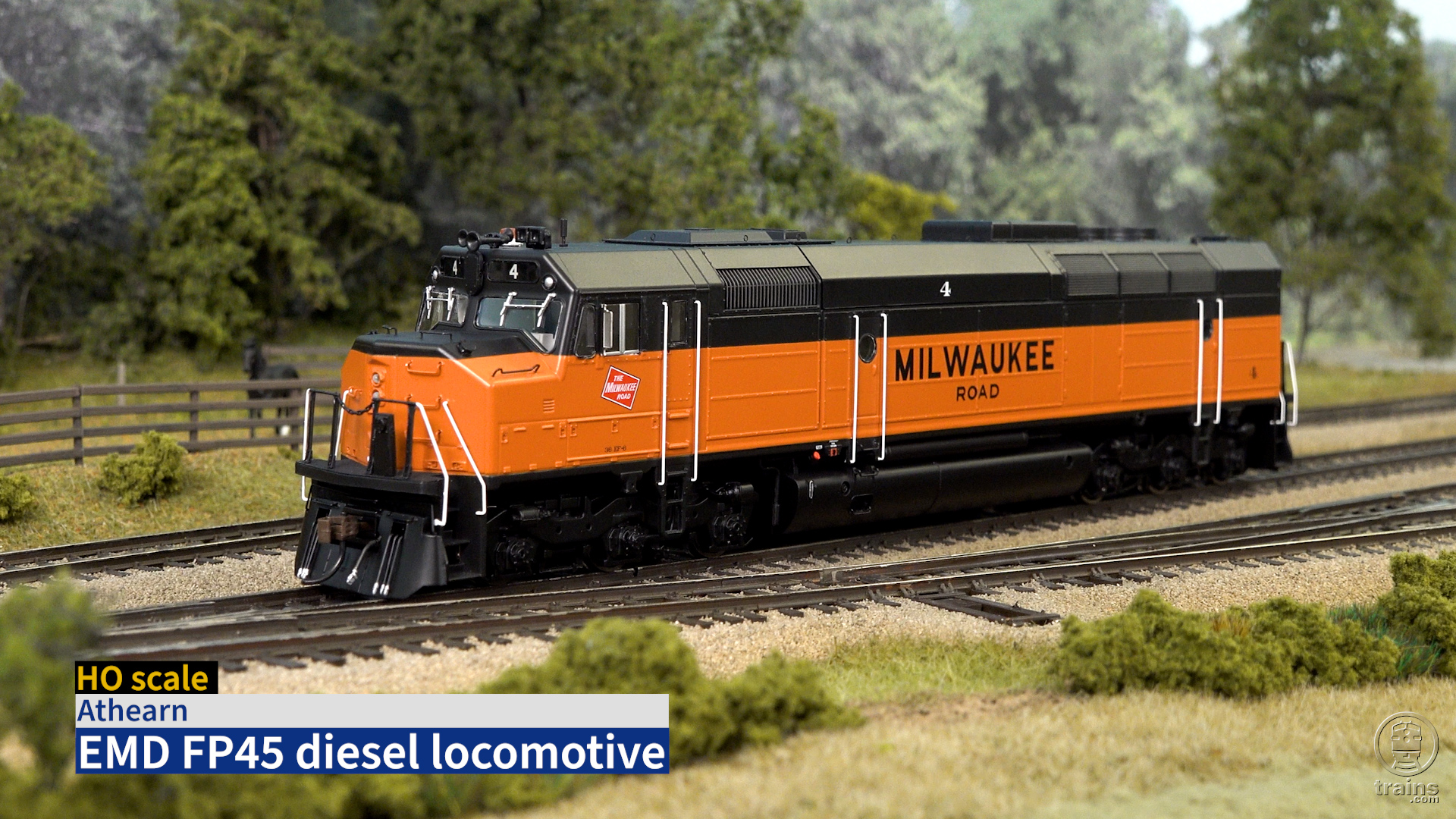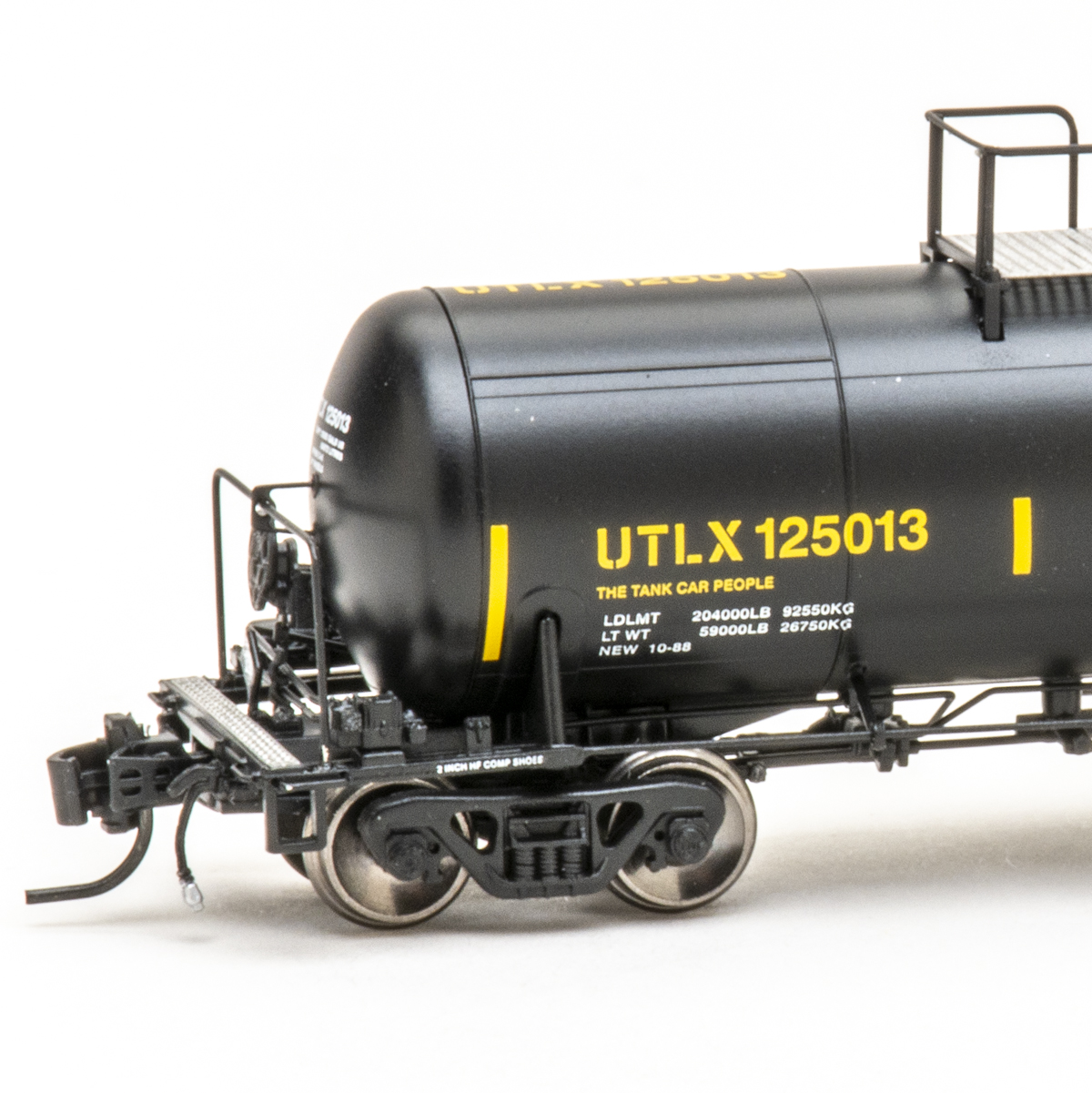The model’s prototype is doubly famous, both for its 1927 launching of what would become a fleet of 65 big 4-8-4s and as the only member of that fleet still operating, thanks to restoration by the San Bernardino Railroad Historical Society in 1991.
The model represents the 3751 as she was rebuilt in 1941 and operated through 1947, with 80″ Boxpok drivers, Wagner cylinder bypass valves, Worthington 6-SA feedwater heater, top-mounted check valves, single large sandbox, and extended cab. The big box tender carrying 7,000 gallons of fuel oil and 20,000 gallons of water had trailed no. 3751 since 1938.
By 1945 the 3751 was equipped with a telescoping extension stack to improve firebox draft and lift smoke above the cab. This stack is cast in the extended position, dramatically increasing the model’s height to a scale 18′-4 ½”.
In 1947, the 3751 was fitted with a folding right-angle deflector hood for use in the many tunnels on the Southern Pacific’s route through the Tehachapi Mountains. This hood was removed during restoration.
All of the smokestacks press-fit into the model’s plastic boiler, although it takes a fair bit of force to remove and insert them. Once the extension stack was on the model I decided to leave it, because it represents one of the most distinctive and memorable features of the Santa Fe 4-8-4s. The deflector hood was probably rarely raised outside of tunnels.
Dimensions and details. Broadway Limited’s model scales out to within an inch or so of most of the 3751’s major dimensions. Notable exceptions are the wheel diameters: the pilot wheels scale 34½” instead of 37″, the drivers are 77″ instead of 80″, and the trailing wheels 42½” instead of 40″.
Manufacturers typically use undersize wheels to improve clearances for tight model curves and oversize flanges. The drivers close enough to look good anyway, and the pilot wheels would look better if they were painted black.
The detailing is what we’ve learned to expect from Broadway, with a combination of cast-on and free-standing piping. The model’s details are generally accurate, but mistakes lurk on the pilot deck.
The real engine has one air compressor on the left side behind the pilot shield and a Worthington hot-water pump on the right. A large hot-water suction pipe comes down from the smokebox to curl forward behind the pilot shield and connect to the bottom front corner of the water pump. The model has compressors behind each side of the shield, an undersize water pump between them, and no hot-water connection from the heater unit on top of the smokebox. The real 3751’s second air compressor hangs below the left side of the cab. That’s where you’ll find a third compressor on the model, but it’s missing some obvious piping connections.
The engine’s front-end appearance is further marred by the handrail on the pump shields, which should have two more right angle bends than it does. Instead of arching upward like a basket handle, its curved section should lie flat and reach back to pass through a stanchion on the smokebox front.
These detail discrepancies are all correctable by modelers with a little patience and experience.
Paint and lettering. The locomotive and tender are painted a dark gray instead of black. I prefer this myself for making detail easier to see. This “off-black” shade could be disappointing, however, to those expecting the polished jet black of the 3751 in excursion service.
The drivers and main frame are a full black, however, and the difference is noticeable. A little weathering could disguise this, but the ends of the driving axles should at least be painted to match the drivers as on the real engine. My approach would be to paint all the engine’s wheels to match the boiler, including those too-shiny pilot wheels.
The color of the smokebox front is too silver. The real engine has a grayer graphite shade, which the Santa Fe called “Tarpon Gray.” The smokestack (all variations), the front-end throttle cover behind the stack, and the exposed corners of the firebox below the smooth jacket should also be Tarpon Gray.
The aluminum lettering is neat and mostly accurate, but the capacity lettering on the rear of the tender is wrong. It shows the capacities of the 3751’s original tender, not the larger tank correctly modeled with the modernized locomotive. The headlight number plate numerals should be silver, and those in the illuminated number boxes ahead of the sandbox should be white.
The high starting voltage is a consequence of the QSI Quantum control system in the DC mode. Although the starting voltage can be adjusted downward for a greater control range, the practical minimum is about 5 volts, as it takes almost that much voltage to power up the control system.
The engine is a much “happier” performer on DCC, and its sound effects are readily operated by the various digital function controls. Unfortunately, the exhaust rate isn’t accurately matched to the drivers, either on DC or DCC. The engine chuffs about three times, instead of four, for each turn of the wheels. Broadway Limited’s director of sales, Tim Nissley, confirmed that there is no way for users to adjust the chuff rate.
With a weight of almost 11/2 pounds, you’d expect this 4-8-4 to be a strong puller. It is, but on my layout it didn’t pull as well as a brass model of the similar weight but with sprung drivers. A replacement driver with a traction tire is included, along with a socket wrench for the crankpin screws; the tire increases drawbar pull by almost 50 percent.
A long-shank Kadee coupler is included to replace the scale dummy coupler on the engine’s pilot. No centering gear is provided, however, and the pilot-mounted Kadee coupler rides half the height of a coupler head too high.
Overall effect. Taken as a whole, the model 3571 does a fine job of representing its prototype, which is widely regarded as a particularly handsome locomotive. It’s a well-built “layout engine” too, one made to rack up many scale miles instead of sitting in a display case. It has flaws, but Broadway Limited Imports has shown an ability to learn from mistakes. Fans of western steam power will be happy to have it and to look forward to comparing BLI releases of Santa Fe (and Union Pacific) locomotives.
Price: $329.99
Manufacturer:
Broadway Limited Imports
Suite 9E/F
601 Shenandoah Village Drive
Waynesboro, VA 22980
www.broadway-limited.com
Description:
Plastic and metal ready-to-run
4-8-4 steam locomotive with
sound
Features:
Automatic dual-mode
(DC/DCC) control and sound
system
Cab interior with backhead
Drawbar pull: 4.16 ounces
(7.2 ounces with optional
traction tire)
Engine and tender weight: 30.5
ounces (engine alone weighs
22 ounces)
Five-pole can motor with
flywheel
Hinged cab deck plate
Kadee magnetic knuckle
coupler at correct height on
tender
Minimum radius: 18″ (larger
radius recommended)
RP-25 contour wheels, in gauge
Sliding cab ventilators
Two optional smokestacks
Road numbers:
Atchison, Topeka & Santa Fe
nos. 3751, 3755, 3762
Painted but unlettered





